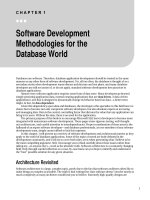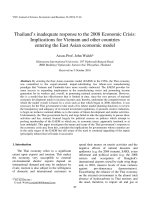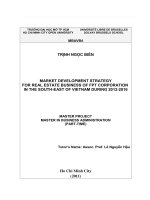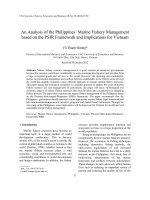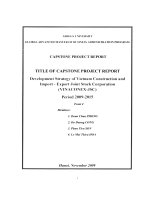Building the IOT software development strategy for vietnam innovation value added services co , ltd during period 2019 – 2024
Bạn đang xem bản rút gọn của tài liệu. Xem và tải ngay bản đầy đủ của tài liệu tại đây (2.23 MB, 93 trang )
ĐẠI HỌC QUỐC GIA HÀ NỘI
KHOA QUẢN TRỊ VÀ KINH DOANH
---------------------
ĐÀO MINH NGỌC
BUILDING THE IOT SOFTWARE DEVELOPMENT STRATEGY
FOR VIETNAM INNOVATION VALUE ADDED SERVICES CO.,
LTD. DURING PERIOD 2019 – 2024
XÂY DỰNG CHIẾN LƯỢC PHÁT TRIỂN PHẦN MỀM IOT CHO
CÔNG TY TNHH CUNG CẤP GIẢI PHÁP DỊCH VỤ GIÁ TRỊ
GIA TĂNG VIVAS TRONG GIAI ĐOẠN 2019 – 2024
LUẬN VĂN THẠC SĨ QUẢN TRỊ KINH DOANH
HÀ NỘI - 2019
ĐẠI HỌC QUỐC GIA HÀ NỘI
KHOA QUẢN TRỊ VÀ KINH DOANH
---------------------
ĐÀO MINH NGỌC
BUILDING THE IOT SOFTWARE DEVELOPMENT STRATEGY
FOR VIETNAM INNOVATION VALUE ADDED SERVICES CO.,
LTD. DURING PERIOD 2019 – 2024
XÂY DỰNG CHIẾN LƯỢC PHÁT TRIỂN PHẦN MỀM IOT CHO
CÔNG TY TNHH CUNG CẤP GIẢI PHÁP DỊCH VỤ GIÁ TRỊ
GIA TĂNG VIVAS TRONG GIAI ĐOẠN 2019 – 2024
Chuyên ngành: Quản trị kinh doanh
Mã số: 60 34 01 02
LUẬN VĂN THẠC SĨ QUẢN TRỊ KINH DOANH
NGƯỜI HƯỚNG DẪN KHOA HỌC: PGS.TS. HOÀNG ĐÌNH PHI
HÀ NỘI - 2019
DECLARATION
The author confirms that the research outcome in the thesis is the
result of author’s independent work during study and research period and it is
not yet published in other’s research and article.
The other’s research result and documentation (extraction, table,
figure, formula, and other document) used in the thesis are cited properly and
the permission (if required) is given.
The author is responsible in front of the Thesis Assessment
Committee, Hanoi School of Business and Management, and the laws for
above-mentioned declaration.
Date…………………………..
ACKNOWLEDGEMENT
From the beginning to the end of this long and sometimes strenuous
journey, I have been greatly supported and cheered along with a great number
of people. It is such a pleasure to offer a sincere and heartfelt thank you to
them all in my humble acknowledgement.
In the first place I would like to record my profound gratitude to my
Supervisor, Assoc. Prof. Dr. Hoang Dinh Phi, for his guidance, supervision
and tactical advice throughout the entire process of writing this research. I am
deeply grateful to be a student of such a kind and supportive Supervisor, who
believe in my potential, and provided me with doses of encouragement and
support in various ways.
I would also like to thank all lecturers at HSB, who have given me the
knowledge and enthusiasm, helping me to complete this thesis. It has been an
honour and pleasure to know them.
Finally, I would like to express my deepest gratitude to my Father,
Mother, my Wife and my two little babies for their strong support in pursuing
my higher education at HSB.
Thank you very much!
<…………, ………/………/……… >
Dao Minh Ngoc
CONTENT
ABBREVIATION .............................................................................................. i
LIST OF TABLES ............................................................................................ ii
LIST OF FIGURES.......................................................................................... iii
INTRODUCTION ............................................................................................. 1
CHAPTER 1. BASIC THEORY ON DEVELOPMENT STRATEGY ........... 6
1.1. THE BASIC CONCEPTS .......................................................................... 6
1.1.1. Strategy ................................................................................................ 6
1.1.2. The necessity of building strategy ....................................................... 9
1.1.3. Levels of strategy ............................................................................... 11
1.1.4. Definition of strategic management ................................................... 12
1.1.5. Process of building strategy ............................................................... 14
1.2. THEORETICAL TOOLS ........................................................................ 15
1.2.1. Porter five forces’ framework ............................................................ 15
1.2.2. IFE & EFE matrix .............................................................................. 18
1.2.3. SWOT matrix ..................................................................................... 21
1.3. INTERNET OF THINGS (IOT) .............................................................. 23
1.3.1 IOT Concept ........................................................................................ 23
1.3.2. Internet of Things review ................................................................... 24
CHAPTER 2. ANALYSIS AND DESIGN OF IOT SOFTWARE
DEVELOPMENT STRATERY FOR VIETNAM INNOVATION VALUE
ADDED SERVICES Co., Ltd DURING PERIOD 2019 – 2024 ................... 28
2.1. COMPANY’S CURRENT SITUATION ANALYSIS ........................... 28
2.1.1. About Vivas ....................................................................................... 28
2.1.2. Major products of the company ......................................................... 29
2.1.3. Financial information ......................................................................... 30
2.1.4. Vivas IOT Technology Center and SCP Platform ............................. 31
2.1.5. IT Software Industry Background ..................................................... 35
2.1.6. Agricultural production in Vietnam ................................................... 36
2.1.7. IoT applications in agriculture ........................................................... 39
2.2. STRATEGY ANALYSIS ........................................................................ 41
2.2.1. Porter’s Five forces framework Analysis .......................................... 41
2.2.2. Summary of interview and the survey ............................................... 44
2.2.3. External Factors Evaluation ............................................................... 51
2.2.4. Internal Factors Evaluation ................................................................ 58
2.2.5. SWOT Matrix .................................................................................... 64
2.3. BUILDING THE STRATEGIES............................................................. 65
2.3.1. SO strategies ...................................................................................... 65
2.3.2. ST strategies ....................................................................................... 66
2.3.3. WO strategies ..................................................................................... 67
2.3.4. WT strategies ..................................................................................... 68
CHAPTER 3. PROPOSAL OF SOLUTIONS................................................ 69
3.1. MISSION, VISION AND CORE VALUE .............................................. 69
3.2. GENERAL SOLUTIONS ........................................................................ 69
3.3. SPECIFIC SOLUTIONS ......................................................................... 70
3.3.1. Product solutions ................................................................................ 70
3.3.2. Human resource solutions .................................................................. 72
3.3.3. Improve product implementation process.......................................... 72
3.3.4. Problems may be encountered during implementation ..................... 74
CONCLUSION, LIMITATION AND IMPLICATION................................. 76
1. Conclusions ................................................................................................. 76
2. Limitations .................................................................................................. 77
3. Implications ................................................................................................. 77
REFERENCES ................................................................................................ 78
ABBREVIATION
Sr. No.
Abbreviation
Full form
1
AI
Artificial Intelligence
2
APEC
Asia-Pacific Economic Cooperation
3
I²oT
Industrial Internet of Things
4
ICT
5
IOCV
6
IOE
Internet of Everything
7
IOT
Internet of Things
8
IT
Information Technology
9
M2M
Machine-to-Machine
10
SCP
Smart Connected Platform
11
VCCI
Vietnam Chamber of Commerce and Industry
12
VINASA
13
VIVAS
14
VNPT
Information and Communications
Technology
Internet of Things
Open Community for Vietnam
Vietnam Software and IT Services
Association
Vietnam Innovation Value Added Services
Co., Ltd
Vietnam Post and Telecommunication
Corporation
i
LIST OF TABLES
Table 1.1: Paradigms Strategy (Teece et al., (14)) ......................................... 10
Table 1.2: The EFE Matrix (Hoang Dinh Phi 2015) ...................................... 18
Table 1.3: The IFE Matrix (Hoang Dinh Phi 2015)........................................ 19
Table 2.1: EFE of Vivas company in IOT (Author 2019) .............................. 51
Table 2.2: IFE of Vivas company in IOT (Author 2019) ............................... 58
Table 2.3: SWOT of Vivas company in IOT (Author 2019) .......................... 64
ii
LIST OF FIGURES
Figure 1.1: Strategic management model (Wheelen & Hunger 2006) ........... 14
Figure 1.2: Four elements of strategic management (Wheelen & Hunger 2006) ... 14
Figure 1.3: Porter five forces’ framework (business-to-you.com 2016) ........ 16
Figure 1.4: SWOT analysis (Hoang Dinh Phi 2015) ...................................... 22
Figure 1.5: IoT viewed as a network of networks (Cisco IBSG 2011) .......... 24
Figure 1.6: Billions of Internet-Connected Devices (MIT Technology Review
2014)................................................................................................................ 25
Figure 1.7: The Digital Universe in 2020 (IDC 2012).................................... 26
Figure 2.1: Vivas turnover bar chart (Author 2019) ....................................... 30
Figure 2.2: Vivas profit line graph (Author 2019) .......................................... 31
Figure 2.3: SCP Highlights (Source: VNPT Technology 2018) .................... 32
Figure 2.4: Overall model of VNPT Technology's Smart Connected Platform
(Source: VNPT Technology 2018) ................................................................. 33
Figure 2.5: SCP main characteristics (Source: VNPT Technology 2018) ..... 34
Figure 2.6: Number of households and enterprises in Agriculture (Author
2019)................................................................................................................ 37
Figure 2.7: Greenhouse distribution chart (Author 2019) .............................. 38
Figure 2.8: potential and useful applications for smart agriculture (Author
2019)................................................................................................................ 39
iii
INTRODUCTION
1. Rationale
One of the key words in the IT industry in 2017 and the first half of
2018 is Internet of Things (IOT). IoT is constantly mentioned in technology
seminars, economic forums or dialogue programs. At Consumer Electronics
Show 2014 (CES), former Cisco chief executive John Chambers predicted the
Internet of Things would be a $19 trillion market over the next several years.
Other estimates are not far off. In 2013, McKinsey (an American worldwide
management consulting firm) report estimated various IoT applications could
have an economic impact about $11 trillion a year by 2025.
During the APEC 2017 Summit, one of the most discussed topics is
whether IoT will replace human labour. Basically, IoT cannot replace people,
but IoT will help people optimize their workforce, make the hard work
become easier. It does not mean that people will stomp on the spot. It means
that people must become smarter, more knowledgeable to master the
technology.
Following the general trend in the world, there are quite a few
companies in Vietnam focusing on developing smart technology solutions and
products based on IoT. There are some familiar names that have been well
received by the market recently such as Lumi, BKAV SmartHome ... One thing
in common among these suppliers is that they focus on smart home appliances
(Smart Home), and target to customers who are willing to spend money to
facilitate their house. These products are focusing invested in designs in order
to make the house more luxurious. The IoT is not only applied in Smart Home
but also in many areas such as health, transportation, environment, agriculture
and so on.
In July 2011, the Vietnam Innovation Value Added Services Co. Ltd
(VIVAS) was officially established under VNPT Technology Joint Stock
1
Company, a member of VNPT Group. As a software engineering company,
Vivas has already owned a few traditional software products. However, in the
current situation, it is essential for a company to create positive changes to keep
up with the trends of technology. Therefore, the company’s board of
management has chosen IoT as an important field to invest and develop. The
goal of company is: “We strive to bring Internet of Things technology to every
sector, every field, to contribute to a better life for people”. To achieve that goal,
it is imperative to build a medium and long-term strategy to ensure the survival
and sustainable development of the company. This is the main reason for the
author to choose the topic "Building the IOT Software Development Strategy for
Vietnam Innovation Value Added Services Co., Ltd. during period 2019 –
2024".
2. Overview of Previous Researches
Over the past few years, the Internet of Things (IoT) has gradually
become a new technology field, attracting the attention and discussion of
many people from technology areas to business areas. Over the world, it
seems that each passing week, there is a business standing out to announce
their decision to implement a new IoT strategy.
There are many researches on IoT in general and building IoT strategies
for businesses in particular. The most famous of these studies is the book
“Building the Internet of Things” by Maciej Kranz (1), Vice President and
General Manager of Corporate Strategic Innovation Group at Cisco. This
book has been translated into Vietnamese and published by Alpha book.
The book discusses about the impact and spread of IoT and the
opportunities that IoT appear daily in the business life. The book also points
out ways to help business leaders to embark on deploying IoT to achieve
short-term and long-term tangible benefits.
2
For the managers or leaders in enterprises, the book discusses about IoT
from a business, strategic, and organizational perspective, along with an
illustrative example of IoT application in practice, to give the readers a clearer
view.
The manager will learn how to build a feasible IoT implementation plan
conforming to the current orientation, strategy, and ability of the business, as
well as how to successfully implement that strategy.
In another study named “Abilities and orientations on the development
of Internet of Things in the World”, posted on The Science and Technology
Policy and Management Journal, Dr. Bach Tan Sinh (2) (from the Institute for
Science and Technology Policy and Strategy Studies) has evaluated the
potential of developing IoT as well as the development trend over the world
in the period 2020 - 2025, thereby giving some suggestions on IoT
development strategy for Vietnam, although the content is still macro and
inclined to the general orientation.
It is possible to find some thesis addressing the issue of building or
orienting IoT strategies. For example, in the thesis of author Mikko Kaukonen
(Lappenranta University of Technology-Finland) named "Profitability
Analysis of Internet of Things Investments", the author questioned: "What are
the most important business dimensions for the IoT investment” and then
pointed out the three key business dimensions that are: Building IoT
ecosystem, Business models and Application areas.
In another thesis by Diogo Andre Gomes “The Internet of Things Developing a Sustainable Competitive Advantage in the Hotel Industry”
(Catolica Lisbon School of Business&Economic-Portugal), the author
performed a strategic analysis of IoT’s functionalities. This analysis aims to
find out what resources can a hotel develop, with such IoT’s functionalities.
Then, the chapter "Strategic Impact of IoT in the Hotel Industry" is
3
developed, with the goal of analyzing what functionalities can the IoT
provide, and how those functionalities can be linked to a value activity in a
hotel’s value chain.
It can be seen that there are some studies mentioning about building
IoT strategy, however, there is no direct topic about building an IoT strategy
for Vivas company. Within the scope of this thesis, the author, by using
different research strategies, interview and survey, and analyzing various
sources, will build a software development strategy in IOT field for Vivas.
Strategic management is in a central position in this Thesis. Books, articles,
research… in area of strategic management and the ongoing evolution in IOT
are also utilized to support this research.
3. Aims of research
The author decided to study and apply basic theory of strategy
management to build the IOT software development strategy for VIVAS during
period 2019 - 2024 as well as to propose some solutions. The aims of research
are:
- To study the theory on strategy and the design of an IOT strategy.
- To synthesize, analyze and evaluate the current situation of software
products and apply the theory to build the IOT software development strategy
at Vivas.
- To propose some suggestions and solutions for Vivas' IOT software
development strategy.
4. Objects of research
This study focuses on the factors that effect and form Viva s' IOT
strategy for developing existing software products and potential IOT products
within the scope of the research which are mentioned below. Based on the
available resources of Vivas, the research will help bring Vivas’s IOT
software products into the market.
4
5. Scope of research
Due to limited time and resources, the author can only focus on basic
assessment of Vivas’s current situation and on the IOT solution for Smart
Agriculture (not included forestry, fishery and livestock).
The author uses the tools for management of strategy, the hard data
from the company in the period of 2014 – 2018, and the soft data gathered by
questionnaire and interview to design the strategy and to forecast for the
period 2019 – 2024.
6. Research methodology
Porter’s five forces framework will be used to assess certain threats that
may affect Vivas’ IoT product such as threat of new entrants, threat of
substitute products or services, the bargaining power of suppliers/buyers and
the intensity of competitive rivalry.
The author used the basic tools such as: Internal/External Factor
Evaluation (EFE, IFE) and SWOT… combined with hard data and soft data to
build the IoT software development strategy.
In order to conduct the study and bring the elements of answers to the
problem, a qualitative approach will be adopted. The author uses the sources of
data from a questionnaire with 10 questions undertaken by managers and
employees.
7. Thesis structure
INTRODUCTION
1. Rationale
2. Literature review
3. Aims of research
4. Objects of research
5. Scope of research
6. Research methodology
5
7. Thesis structure
CHAPTER 1. BASIC THEORY ON DEVELOPMENT STRATEGY
CHAPTER 2. ANALYSIS AND DESIGN OF IOT SOFTWARE
DEVELOPMENT STRATERY FOR VIETNAM INNOVATION
VALUE ADDED SERVICES Co., Ltd DURING PERIOD 2019 – 2024
CHAPTER 3. PROPOSAL OF SOLUTIONS
CONCLUSION, LIMITATION AND IMPLICATION
CHAPTER 1. BASIC THEORY ON DEVELOPMENT STRATEGY
1.1. THE BASIC CONCEPTS
1.1.1. Strategy
The concept of strategy has been borrowed from the military and adapted
for use in business. It is a term that comes from the Greek strategist, meaning
"generalship". In wars, strategic terms are frequently mentioned and
understood as a way to gain advantage over rivals, it is more artistic than
scientific.
Since the mid-twentieth century, the strategic term has been widely used in
the economic field. In business, as in the military, strategy bridges the gap
between policy and tactics. Together, strategy and tactics bridge the gap
between ends and means.
Strategy According to B. H. Liddell Hart (3)
In his book, Strategy, Liddell Hart examines wars and battles from the time
of the ancient Greeks through World War II. Concluding his review of wars,
policy, strategy and tactics, Liddell Hart arrives at this short definition of
strategy: "the art of distributing and applying military means to fulfil the ends
of policy." Deleting the word "military" from Liddell Hart’s definition makes
it easy to export the concept of strategy to the business world.
6
Strategy According to George Steiner (4)
George Steiner is generally considered a key figure in the origins and
development of strategic planning. His book, Strategic Planning, is close to
be a bible on the subject. Yet, Steiner does not bother to define strategy
except in the notes at the end of his book. There, he notes that strategy entered
the management literature as a way of referring to what one did to counter a
competitor’s actual or predicted moves. Steiner also points out in his notes
that there is very little agreement as to the meaning of strategy in the business
world.
Strategy According to Henry Mintzberg (5)
Henry Mintzberg, in his 1994 book, The Rise and Fall of Strategic
Planning, points out that people use "strategy" in several different ways, the
most common being these five:
- Strategy is a plan, a "how," a means of getting from here to there.
- Strategy is a pattern in actions over time; for example, a company that
regularly markets very expensive products is using a "high end"
strategy.
- Strategy is position; that is, it reflects decisions to offer particular
products or services in particular markets.
- Strategy is perspective, that is, vision and direction.
- Strategy is a ploy, a specific "maneuver" intended to outwit an opponent
or competitor
Strategy According to Kenneth Andrews (6)
Kenneth Andrews presents this lengthy definition of strategy in his book,
The Concept of Corporate Strategy: "Corporate strategy is the pattern of
decisions in a company that determines and reveals its objectives, purposes,
or goals, produces the principal policies and plans for achieving those goals,
7
and defines the range of business the company is to pursue, the kind of
economic and human organization it is or intends to be, and the nature of the
economic and non-economic contribution it intends to make to its
shareholders, employees, customers, and communities.”
Strategy According to Michael Porter (7)
In a 1996 Harvard Business Review article, Porter argues that competitive
strategy is "about being different." He adds, "It means deliberately choosing a
different set of activities to deliver a unique mix of value." In short, Porter
argues that strategy is about competitive position, about differentiating
yourself in the eyes of the customer, about adding value through a mix of
activities different from those used by competitors. In his earlier book, Porter
defines competitive strategy as "a combination of the ends (goals) for which
the firm is striving and the means (policies) by which it is seeking to get
there." Thus, Porter seems to embrace strategy as both plan and position. (It
should be noted that Porter writes about competitive strategy, not about
strategy in general.)
What is strategy?
What, then, is strategy? Is it a plan? Does it refer to how we will obtain the
ends we seek? Is it a position taken? Or does strategy refer to perspective.
Lastly, does strategy refer to a pattern in our decisions and actions?
To answer these questions, the author would like to borrow the basic
definition of Assoc. Prof. Dr. Hoang Dinh Phi (8) on strategy: a strategy of an
organization or a company is a document, either written, printed or electronic,
in which the responsible people set out long-term mission, vision, core value,
and strategic objective for 5 years as standard, as well as the resources to be
mobilized and solutions to be implemented in order to achieve the set
objectives. Embodied content is included:
1. Mission
8
2. Vision
3. Core Values
4. Objectives
5. Resources
6. Solutions
1.1.2. The necessity of building strategy
In the early stages of the formation and development of strategic
management theory, many people have argued that strategy is a long-term
plan, an integral part of the organization's planning system and therefore they
emphasize the function of strategic planning. Although there are many
different studies and presentations on strategic management, the current
strategic management is defined as both science and art of planning,
implementing and evaluating. Throughout its development, the concept of
strategic management has been greatly expanded. Currently, the strategic
management process is a continuous process, and requires the participation of
all members of the organization.
The undeniable importance of strategy has been widely stressed in the
literature. But In fact, many businesses, especially small and medium
enterprises, have little interested in strategic issues, they even do not identify
themselves any strategy. The main reason is they are not aware of the
important role of strategy. The problem is not only big businesses need a
strategy, but small businesses also need it, we must to make sure that any
organization or business needs a strategy. The presence of strategy in the
enterprise depends on the awareness of the role of the strategy as well as the
knowledge of strategic science of business managers. A question asked by
many managers is "Why organizations really do need strategies?"
To answer this question, Mintzberg (9) explained four basic reasons for
managers and scientists to better understand the important role of strategy for
9
an organization in general and for a business in particular. According to
Mintzberg, businesses need a strategy because: 1. strategy is needed to set
direction for themselves and to outsmart competitors, or at least enable
themselves to maneuver through threatening environments; 2. strategy is
needed to focus effort and promote coordination of activity; 3. strategy is
needed to define the organization; and 4. Strategy is needed to reduce
uncertainty and provide consistency.
From this point of view, if its strategy is good, then the organization can
make various mistakes, indeed can sometimes even start from a weaker
position, and still come out on top. Chandler (10) asserted that: "Business is
like war in one respect-if its grand strategy is correct … any number of
tactical errors can be made and yet the enterprise proves successful."
According to Whittington (11) strategy work is a “serious business”, Barry
and Elmes (12) called it “the most prominent, influential and costly stories told
in organizations”. It is very popular in business training schools, especially for
MBA degrees that strategic management is considered as one of the most core
subjects.
There are many theories, many researchers have developed and
implemented in strategic areas, along with many different approaches to
business strategy (Table 1 below). Strategic management studies often deal
with key questions about how to achieve and maintain a competitive
advantage (Rumelt, Schendel and Teece (13)), and in a simplified word, what
is the source of competitive advantage.
Table 1.1: Paradigms Strategy (Teece et al., (14))
10
1.1.3. Levels of strategy
Most academics classify strategies into three levels:
Corporate strategy - what business or businesses the firm should be in?
It relates to the future formula and structure of the company and affects the
rationale of the company and the business in which it intends to compete.
Corporate level strategy defines the business areas in which company will
operate. It deals with aligning the resource deployments across a diverse set
of business areas, related or unrelated. Strategy formulation at this level
involves integrating and managing the diverse businesses and realizing
synergy at the corporate level. The top management team is responsible for
formulating the corporate strategy. The corporate strategy reflects the path
toward attaining the vision of organization.
Competitive or business strategy - how each business attempts to achieve
its mission within its chosen area of activity.
Here strategy is about which products or services should be developed and
offered to which markets and the extent to which the customer needs are met
whilst achieving the objectives of the organization.
11
Business level strategies are formulated for specific strategic business units
and relate to a distinct product-market area. It involves defining the
competitive position of a strategic business unit. The business level strategy
formulation is based upon the generic strategies of overall cost leadership,
differentiation, and focus.
Operational or functional strategies - how the different functions of the
business support the corporate and business strategies.
They are concerned with how the various functions of the organization
contribute to the achievement of strategy It examines how the different
functions of the business (marketing, production, finance etc) support the
corporate and business strategies. Such corporate planning at the operational
level is means oriented and most activities are concerned only with the ability
to undertake directions. The strategies at the functional level involve setting
up short-term functional objectives, the attainment of which will lead to the
realization of the business level strategy.
1.1.4. Definition of strategic management
According to Wheelen & Hungers’study (15), strategic management is a set
of managerial decisions and actions that determines the long-run performance
of a corporation. It includes environmental scanning (both external and
internal), strategy formulation (strategic or long-range planning), strategy
implementation, and evaluation and control. The study of strategic
management, therefore, emphasizes the monitoring and evaluating of external
opportunities and threats in light of corporation’s strengths and weaknesses.
From the perspectives of Dess and Miller (16), strategic management is a
process that combines three major interrelated activities: strategic analysis,
strategy formulation and strategy implementation.
12
From Hoskisson’s point of view (17) strategic management is primarily
concerned with the actions of the organization to gain a competitive
advantage and create value for organizations and partners. Strategic
management can also be defined as a systematic process that identifies an
organization's internal and external factors to define better targets, formulate,
evaluate and implement strategies to achieve the target. In the above
definition, there are two main points to take note: competitive advantage and
value creation.
In simple terms, it can be understood as a process of developing,
implementing and evaluating strategies according to the figure below. It is a
way to gain competitive advantage for an organization. Regardless of the
scale, every organization needs to adopt a strategy that is best planned to
survive and compete in the market and try to optimize for tomorrow following
today's trend. This is also the purpose of strategic management.
13
Figure 1.1: Strategic management model (Wheelen & Hunger 2006)
1.1.5. Process of building strategy
After having an overview of strategic management, we should find out the
strategy-building process. Wheelen & Hunger (2006) point out strategic
management consists of four basic elements. These are environmental
scanning, strategy formulation, strategy implementation and evaluation.
Figure 1.2: Four elements of strategic management (Wheelen & Hunger 2006)
14
The figure above illustrates how these four elements interact. To do this,
first, it is necessary to analyze the current situation and understand the
company's position in the market. It is then possible to decide what kind of
strategy is best for the company. Next, put the strategies into action and see
how it works. If it does not work, it must be reevaluated and change another
one. This is a complete recycle process.
1.2. THEORETICAL TOOLS
1.2.1. Porter five forces’ framework
The five forces’ framework developed by Michael Porter (18) has
dominated the strategic model ever since. This theory is based on the concept
that there are five forces that determine the competitive intensity and
attractiveness of a market. Porter’s five forces help to identify where power
lies in a business situation. This is useful both in understanding the strength of
an organization’s current competitive position, and the strength of a position
that an organization may look to move into.
Strategic analysts often use Porter’s five forces to understand whether new
products or services are potentially profitable. It useful to understand both the
strength of current competitive product situation, and the strength of an
opportunity that the organization is seeking to move to. By understanding
where power lies, the theory can also be used to identify areas of strength, to
improve weaknesses and to avoid mistakes.
In the model shown in Figure 1, the five undeniable competitive forces
are: 1. Threat of new entrants 2. Risk of replacement threats 3. The bargaining
power of buyers 4. The bargaining power of suppliers. and 5. Rivalry among
existing companies. Basically, the companies should find and develop a
position in their industry so that they can best protect themselves against
competing forces or influence on them, thereby determining whether the
company can achieve competitive advantage or disadvantage. In 1985, Porter
15
(19) also noted that the fundamental basis of being superior to competitors
and achieving long-term outstanding profits is called a sustainable
competitive advantage.
Figure 1.3: Porter five forces’ framework (business-to-you.com 2016)
Each element of the framework has contributed to the industry and the
firm’s profitability.
The first force, “Threat of New Entrants”: New entrants in an industry
bring new capacity and the desire to gain market share. The seriousness of the
threat depends on the barriers to enter a certain industry. The higher these
barriers are entry, the smaller the threat for existing players.
The second force: “Bargaining Power of Buyers” is also described as the
market of output. This force analyzes the degree that customers can put
pressure on the company, which also affects customers' sensitivity to price
changes. Customers have a lot of power when they have finite numbers and
many alternatives to purchase. Moreover, they can also easily switch from
one company to another. However, buying power is low when customers
16
